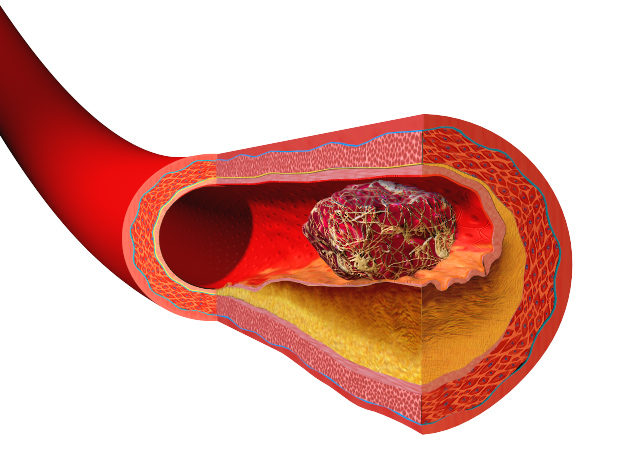Difference Between Blood Clot and Leg Cramp
What is Blood clot?
What is the definition of Blood clot?
A blood clot is also known as a thrombus and describes a clump of blood cells, platelets, and fibrin that forms to stop blood flow. Blood clots stop people bleeding to death but can be a problem if they form in the wrong place.
Symptoms of Blood clot:

Symptoms only present if the clot is formed in the wrong place, in which case the symptoms will depend on where the clot is. If it is a clot in a coronary artery that is found on the heart then you will likely experience chest pain, dizziness, and shortness of breath. A blood clot in the brain causes a stroke with symptoms such as a sudden headache, weakness and drooping on one side of the body. You may also have difficulty in vision or speech. A clot in a deep leg vein is called a deep vein thrombosis (DVT) and can include symptoms of leg pain and swelling.
How do you Diagnose Blood clot?
Diagnosis can be made based on CT scans or MRI scans. An angiogram can also be done to check blood flow to the heart and brain.
Causes of Blood clot:
Clots in arteries can occur when the inner lining of the blood vessel is damaged. This can be associated with plaque buildup over time and when a piece of plaque breaks off it can cause a blood clot to form. A DVT can be due to injury, limited movement, and medical conditions. Various conditions can cause blood clots including blood clotting conditions such as factor V Leiden and antiphospholipid syndrome. Other conditions that cause clots include atherosclerosis, arteriosclerosis, and heart problems.
Risk factors involved in Blood clot:
Risk factors for blood clots include high cholesterol, high blood pressure, being obese, having diabetes and smoking. Risk factors for a DVT include limited movement, surgery, pregnancy, birth control pills, having blood clotting disorders, heart failure and being overweight.
What are the treatments for Blood clot?
Blood clots in the heart and brain need to be treated to avoid heart attack and stroke. DVT can result in a deadly blood clot in the lung (pulmonary embolus), thus DVT needs to be treated. Medication known as thrombolytic agents can be given for removing clots. Anticoagulants such as heparin can be given to prevent future clots from forming. In extreme cases, surgery may be needed.

What is Leg cramp?
What is a definition for Leg Cramps?
A leg cramp is a severe pain in the leg that is usually caused by an involuntary spasm of the leg muscle or muscles.
What are the signs and symptoms of Leg Cramps?
Symptoms include severe pain where the muscle is in spasm. They often occur in the calf muscles but can occur also in the thigh muscles and may last for seconds or minutes, during which time you may also feel or see a hard lump.
Diagnosis:
A doctor performs a physical exam and can do blood tests to check electrolyte levels in the blood.
Possible Causes:
There are several potential causes of leg cramp including blood vessel problems such as deep vein thrombosis. Often if it is a muscle spasm it can be because of dehydration in which your electrolytes are imbalanced. Electrolytes such as sodium, chloride, potassium, and magnesium are important for normal muscle function. Over-exercise can also lead to muscle strain. In older people compression of the spine can lead to pain traveling into the legs.
Risk factors involved in Leg Cramps:
Dehydration is a significant risk factor for muscle cramps. Muscle cramps are also more common in pregnant women, in older people and if you have certain medical conditions such as diabetes or thyroid or liver problems.
What are the treatments for Leg Cramps?
Treatment method depends on the cause, if it is DVT, and then medication may be needed. Leg cramps can usually be treated using hot and cold compresses, massaging the leg, and taking in electrolytes.
Difference between Blood clot and Leg cramp?
-
Definition
A blood clot is a clump of blood cells, platelets and fibrin while a leg cramp is a painful muscle spasm.
-
Symptoms
Symptoms depend where the clot is found and may include chest pain, headache, shortness of breath and leg pain. Symptoms of a leg cramp include leg pain, swelling and a hard lump.
-
Diagnosis
A blood clot can be diagnosed with an MRI, CT scan or angiogram. A leg cramp can be diagnosed by a physical exam and blood tests.
-
Causes
Blood clots can be caused by plaque breaking off in blood vessels, having conditions like factor V Leiden, antiphospholipid syndrome, atherosclerosis, arteriosclerosis, and heart problems, also being immobile or having surgery, being pregnant or on birth control pills. Leg cramps can be caused by DVT, over exercise, electrolyte imbalances or spinal compression.
-
Risk factors
Risk factors for blood clots include having high blood pressure or cholesterol, being obese, having diabetes and smoking, having limited movement, surgery, pregnancy, birth control pills, having blood clotting disorders, or heart failure. Risk factors for leg cramps include dehydration, pregnancy, being older, having thyroid or liver problems or diabetes.
-
Treatment
Blood clots can be treated with thrombolytics, anticoagulants or surgery, while leg cramps can be treated with hot and cold compresses, massaging the leg, taking in electrolytes and taking in medication.
Table comparing Blood clot and Leg cramp

Summary of Blood clot Vs. Leg cramp
- A blood clot is a clump of blood cells, platelets and fibrin while a leg cramp is a severe pain in the leg often caused by a muscle spasm.
- There are several causes of blood clots and leg cramps.
- Risk factors for blood clots can include high blood pressure and cholesterol while risk factors for leg cramps include being dehydrated or having certain illnesses such as diabetes.
- Difference Between Rumination and Regurgitation - June 13, 2024
- Difference Between Pyelectasis and Hydronephrosis - June 4, 2024
- Difference Between Cellulitis and Erysipelas - June 1, 2024
Search DifferenceBetween.net :
1 Comment
Leave a Response
References :
[0]Image credit: https://commons.wikimedia.org/wiki/File:Blausen_0088_BloodClot.png#/media/File:Blausen_0088_BloodClot.png
[1]Image credit: https://upload.wikimedia.org/wikipedia/commons/thumb/b/b6/Bishop_Loughlin_Games_-_Armory_-_Track_%26_Field_%2811609407975%29.jpg/640px-Bishop_Loughlin_Games_-_Armory_-_Track_%26_Field_%2811609407975%29.jpg
[2]Levin, Michael C. “Muscle Cramps”. Merckmanuals. Merck & Co., 2016, https://www.msdmanuals.com/professional/neurologic-disorders/symptoms-of-neurologic-disorders/muscle-cramps
[3]Moake, Joel L. “Overview of thrombotic disorders”. Merckmanuals. Merck & Co., 2018, https://www.msdmanuals.com/professional/hematology-and-oncology/thrombotic-disorders/overview-of-thrombotic-disorders
[4]Riley, J. D., and S. J. Antony. "Leg cramps: differential diagnosis and management." American family physician 52.6 (1995): 1794-1798.

The chart is really helpful. I’m sure i had a left cramp in the middle of the night. Very sore and painful. Although i do have blood vessels that are noticeable on my foot i have been diagnosed with peripheral neuropathy, neuroma, and plantar fasciitis. Hopefully it’s not the early signs of dvt